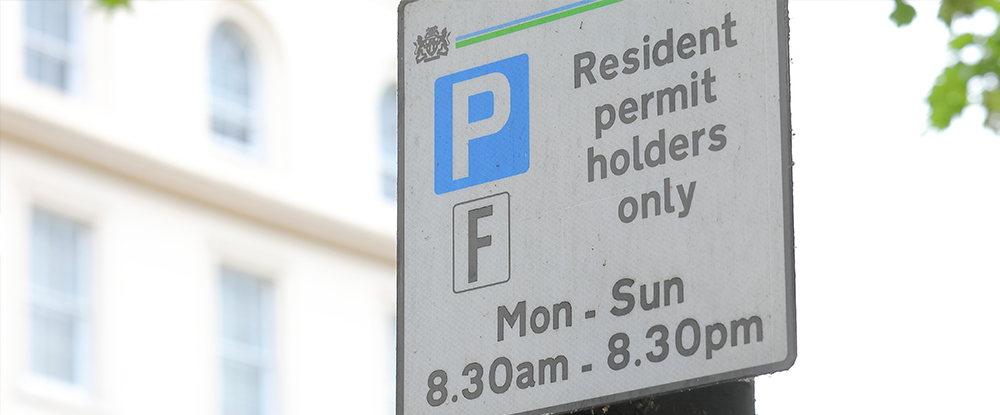If you have ever had to try to park in a busy street, you will have likely come across a “permit holders only” sign. They are frequently found in residential roads or built-up areas like London, where parking by the side of the road is extremely limited.

But what do these signs mean, who do they apply to, and are there penalties for not paying attention to them? In this guide, we will take a look at the common types of permit holder parking signs, what the consequences are of ignoring them, and explain where and when you are allowed to park by them.
What does “permit holders only” mean?
Permit holders are people who have official documentation giving them permission to park in an area. Often, such permit documents will be provided by the local council for a fee. A road sign stating “permit holders only” by a road means that only vehicles with permits are allowed to park in that location. Permit holders will often display their permit in the front window of their vehicles to show traffic wardens that they are permitted to park there.
For example, if you are taking driving lessons in Oxford, you may come across many areas with these signs. This is because Oxford City Council runs a Residents Parking Permits Scheme for council-owned parking areas, on top of other parking restrictions in the area, to enable local residents to access parking when there are limited spaces.
Types of permit holder parking signs
There are several variations of these permit holder parking signs, and all have slightly different meanings. See below for a list of the most common ones and what they mean.
- “Resident permit holders only” meaning: This sign shows that only people with a specific permit, a “resident permit”, can park in this area. Usually, you can only obtain a resident permit if you can prove that you live in that area, so if you are wondering, “Can I park in a resident permit holders only space?” and you do not live in the area, the answer is no.
- “Permit holders only Monday to Friday” meaning: Some signs will include days and times to show the specific times when only permit holders may park in the area. At other times, non-permit holders can park without penalties. Only those with a valid permit could park by this sign on weekdays; on weekends, anyone could park there.
- “Permit holders excepted” meaning: This sign means that any restrictions in place in the area do not apply to people who hold the relevant permit.
It is essential to read these signs and pay attention to the times and dates to ensure you do not incur fines. One of our driving instructors in Ipswich had a pupil who, just after their test, chose to park next to a parking sign with “Mon-Sat 8am-6pm”, meaning they were permitted to park there any day from Monday to Saturday between 8am and 6pm. Unfortunately, they had parked there during these hours, and they were fined as a result. This put a dampener on their recent achievement, and the instructor has always remembered their experience since.
The sign may also indicate which specific permit applies; the type of permit will be displayed inside a black square with white text. Examples include, but are not limited to, N1, C1, AM, W1, and MD. The sign in the image above warns that you cannot park your vehicle there between 8:30 am and 6:30 pm any day of the week unless you are a resident holding a valid F permit. Outside of this timeframe, anyone can park there. For example, if you did not have an F permit, you could park there on Monday at 6:31 pm and then move your car by 7:59 am on Tuesday.
Can disabled badge holders park in “permit holders only” zones?
If you are a disabled badge holder (also known as a Blue Badge holder), you are often allowed to park in areas where there are permit holder parking restrictions. However, this can vary between areas, so it is important to always check the signage and local Blue Badge rules on the government website.
What happens if you park in “permit holders only” zones without the right permit?
If you park in a “permit holders only” parking area without the correct permit, you will likely receive a Penalty Charge Notice (PCN) or a Fixed Penalty Notice (FPN). This will be sent to the registered vehicle owner or tucked under the windscreen wiper.
It will include a fine to be paid. The amount you are charged will depend on the area you parked in and the council that issued the fine.
What to do if you are unsure
Finding parking in busy areas can be very tricky, especially if you are taking driving lessons in Manchester or navigating the city as a learner driver. In some areas, there just isn’t enough parking available, which leads drivers, particularly those who are not local, to search for parking on residential streets. The signage can also be poor.
In these circumstances, the best thing to do is look at the other cars that are parked there. If there are a lot of available spaces along a residential street during the day or at a busy time of year (such as Christmas), then the chances are it’s either pay and display or it’s for permit holders only. If in doubt, be cautious and look for your nearest public car park.
What every driver should remember about “permit holders only” signs
These signs, as frustrating as they can be when you are looking for a parking space, are essential for enabling access to parking for those in the area who are entitled to it. Therefore, whether you are a local permit holder, simply visiting, or taking driving lessons in the area, it is also crucial to understand the signage so that you can avoid any stress, confusion, or fines.
Always read the signs carefully to ensure you are following the rules, and if you are unsure, park somewhere else. This could make the difference between getting a great space legally and being on the receiving end of an unwanted penalty notice.

Written by Anthony Johnson
Grade A - 51/51
ORDIT Registered Trainer







